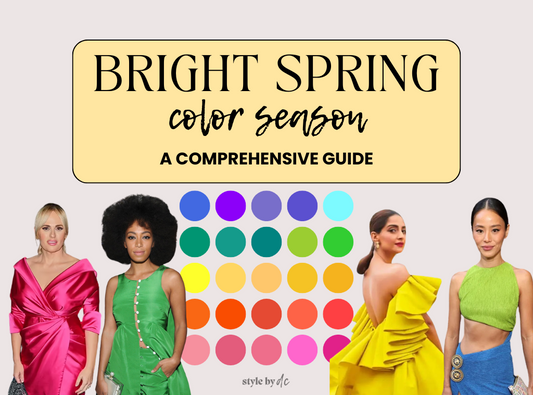Can Every Season Wear Black? A Guide to Wearing Black for All Seasonal Color Types
Black is one of the most universally beloved colors in fashion and personal style. When I ask clients which colour they don’t want to give up, many say black. This is for a few reasons that we don’t need to go deep on right now - but black is perceived as a sophisticated color, a staple color and a comfortable color. It’s easy and it “goes with everything”.
But, does it go with everyone? In the world of seasonal color analysis, black is not equally flattering for every season. Some palettes embrace it fully, while others may struggle to incorporate it harmoniously. I’ve got some good news though - if you love black, you don’t have to get rid of it from your wardrobe! The key is understanding which seasons naturally contain black and how others can strategically wear it without looking overwhelmed. If you’ve just googled “can I wear black?” I’ve got you!
Which Palettes Contain Black?
Black is a deep, cool, and intense color. It thrives in palettes that share these characteristics, meaning it is best suited for the Winter seasons:
True Winter – Black is a dominant color in this palette and works beautifully against the high contrast and cool tones of True Winter individuals.
Dark Winter – While slightly warmer than True Winter, Dark Winter still benefits from black’s depth and intensity.
Bright Winter – Though Bright Winter thrives on high contrast, pure black can sometimes be a little harsh. It’s best balanced with its bold, crisp colors.
Conversely, black does not generally appear in Spring, Summer, or Autumn palettes. That said, every season can still find ways to make black work with strategic styling choices.
Not sure which season you are? Take the free quiz:
How Each Season Can Wear Black
Winter Seasons: Best Fit for Black
True Winter: Can wear head-to-toe black effortlessly. Pair it with icy brights, crisp whites, or jewel tones for a striking contrast.
Dark Winter: Black works well, but adding deep, rich shades like dark teal, burgundy, or pine green softens the effect.
Bright Winter: Instead of solid black, opt for high-contrast patterns that mix black with white, vibrant fuchsia, or electric blue for a more dynamic look.

Autumn Seasons: Deep Alternatives to Black
Autumn palettes lean warm and earthy, making black feel too stark. Instead:
True Autumn: Black is too harsh. Opt for deep brown, warm charcoal, or bronze-based neutrals.
Dark Autumn: Can handle black better than other autumns, but deep espresso, inky navy, or dark olive are more harmonious. Even a deep charcoal can work for this season.
Soft Autumn: Black tends to overwhelm. Soft charcoal, warm gray, or taupe create a more flattering effect.

Summer Seasons: Softer Approaches to Black
Summers thrive on cool, muted, and soft tones, meaning black can be overpowering. Workarounds include:
Light Summer: Black is most overpowering to this palette. Opt for deep muted navy or grey instead.
True Summer: Soft charcoal or a cool, muted navy is a far better alternative to black.
Soft Summer: Black is too heavy, so opt for light charcoal, dusty gray, or cool taupe instead. If wearing black, balance it with soft, muted pastels near the face.

Spring Seasons: Bright and Warm Adjustments
Spring palettes are warm and lively, making black feel too heavy. Instead:
Bright Spring: Black can sometimes work with this palette depending on your natural features (for example - it goes well with Springs that have dark brown hair), but high-contrast elements (like black with cream or a bright color) can also work.
True Spring: Avoid black and go for warm navy, chocolate brown, or camel.
Light Spring: Black is extremely harsh—stick to light taupes, soft browns, or warm grays.

How to Wear Black If It’s Not in Your Palette
If black isn’t a perfect match for your season but you still love it, here are some ways to make it work:
1. Keep it Away from Your Face – Wearing black as pants, skirts, or shoes is far more forgiving than having it near your face.
2. Pair It with Your Best Colors – Soften black with one of your most flattering colors near your face, like a scarf, statement necklace, or jacket.
3. Opt for Softer Shades – If your season is overwhelmed by black, try dark charcoal, espresso, or deep navy instead.
4. Wear it sheer - Wearing black as a lace or sheer top minimizes the starkness of the color.
5. Use Makeup to Adjust Contrast – For those in lighter or softer seasons, a strong black outfit can be balanced with softer makeup tones.
But most importantly - if you love black, wear it! Remember that color analysis is a tool, not a rule. If it goes with your vibe and your style, it’s going to look great no matter what!

Should Every Season Wear Black?
While black is a fashion staple, it’s not universally harmonious. Winters can wear it effortlessly, while other seasons can adjust how they incorporate black to maintain harmony (balance) with their natural coloring. The most important thing is to wear colors that enhance your natural beauty and make you feel confident—whether that includes black or not!
Get your personalized color analysis to find out how to wear black for your season:



